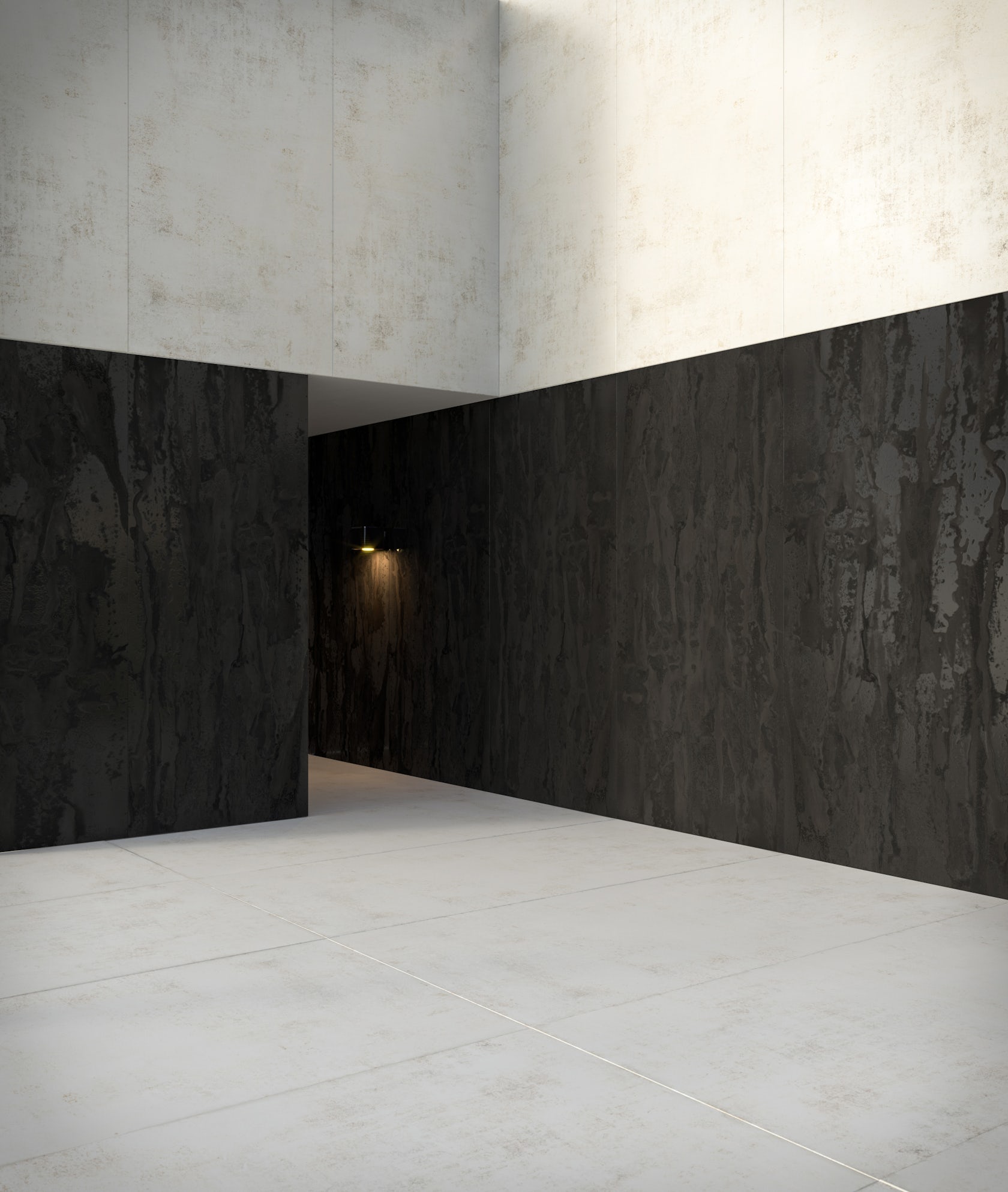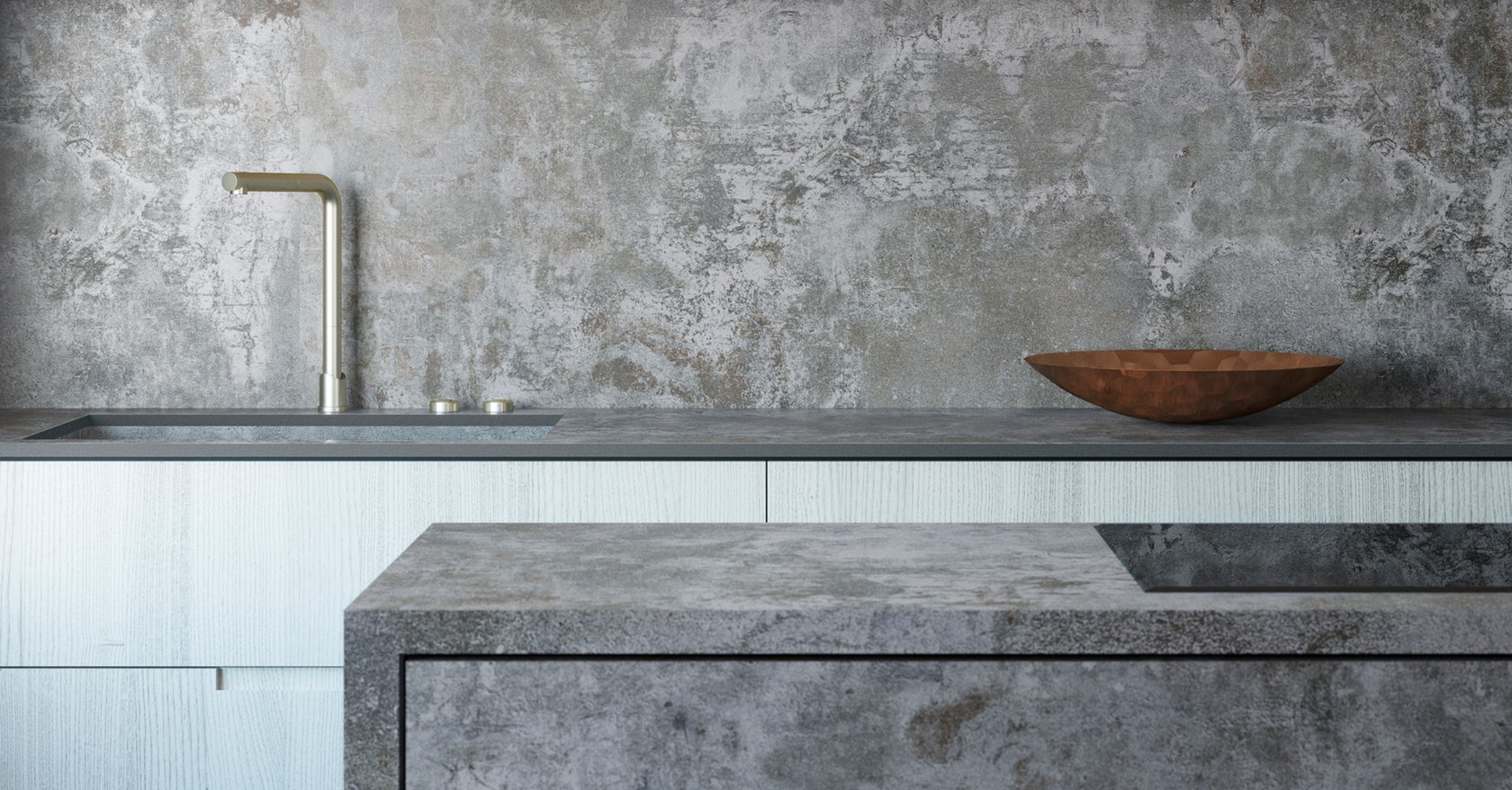Everything old is new again. While Cosentino is designing the next generation of their state-of-the-art, innovative surfaces, they are keeping in mind that many designers are looking for interiors that feel warm and inviting with a comfortable patina of age. The newest colors and patterns for the Dekton Industrial line are richly textured surfaces redolent of beautifully aging concrete and metal.

Dekton Radium and Dekton Blanc Concrete on a façade
Dekton is Cosentino’s ultracompact surface product that uses the latest technology in glass, porcelain and quartz surface manufacturing to create a beautiful and resilient material that can be used anywhere in the home. Dekton is manufactured using the same forces that create natural stone, only rather than acting over millions of years, the industrial process applies them in minutes. Extreme heat and pressure are applied to the powdered raw materials, which turns them into an incredibly strong solid. The slabs are then sinterized, or heat-sealed, to produce an extraordinarily smooth and flawless surface. This innovative use of material and technology is what separates Dekton from its competitors.
In collaboration with designer Daniel Germani, Dekton has released their new Industrial collection with four colors that capture the essence of beautifully aging minerals. “The inspiration came from aged, devastated materials,” said Valentin Tijeras Vice President of Global Product & Research and Development, Marketing. The Industrial line is about “the beauty of imperfection.” The four colors — Nilium, Trilium, Radium and Orix — embrace the grit of urban living with the timelessness of modern architecture’s bones.

Dekton Trilium
Trilium evokes corten steel and volcanic rock with its reddish brown surface accented by black and grey. The first color of the new series to have been launched, Trillium is produced with 80% recycled raw material.

Dekton Radium
Also comprising 80% recycled materials from Dekton’s own production process, Radium is a darker offering that captures the essence of acid-washed steel. The warm undertones are balanced by a cool textured metallic sheen that completes its industrial appearance.

Dekton Nilium
Nilium is a subtler, off-white that reflects the silvers and light warm tones of the beginning of the oxidation process. It’s light texture brings signs of life to a white palette.

Dekton Orix
Orix is a concrete-inspired gray that embraces the green and blue tones that cement takes on after a long life outside.
The designers at Cosentino carefully created these patterns so that they would evoke familiar textures without explicitly quoting them. The intention is not for Dekton to trick someone into thinking that it’s something else. Instead, the colors take advantage of the material’s strength and durability by embedding the pattern into the surface of the material itself. The colors work with the relief texture to create a unified, elegant finish.
Cosentino’s manufacturing technology can do more than just create supple tones. It can shape three dimensional textures and surface qualities inspired by the diversity of natural forms. “We can do almost anything you can imagine,” Tijeras said. “We combine up to 16 different decoration techniques.”

Detail of Dekton Trilium
Even with their state-of-the-art technology, Cosentino had more to learn in order to create the new effects for Dekton. “In the industrial series, the challenge was to have an aged material that looked very natural and at the same time that had some metallic reflections,” Tijeras said. “We had to figure out how to get these metallic reflections in a durable product and with a natural aspect. For that, we had to develop a new printing and glaze technique.” The result that the Industrial collection has all of the richness of a metal or stone with all of the reliability of their careful manufacturing process.
Dekton’s collaborator for this collection, Daniel Germani, has a natural understanding of the line and the stylish potential of richly textured materials. His own work as an interior and furniture designer plays with richly grained woods and robust forms that speak to his home in the American Southwest. In the Industrial collection he and the designers at Dekton took inspiration from loft apartments and spaces that have reclaimed and re-adapted historic warehouses and factories. Combined with Germani’s careful sensibilities, these contemporary references have created a product appropriate for a wide range of uses and installations.

Dekton Radium and Nilium
The future of Dekton and Cosentino is sure to bring more innovations in both style and technology to their solid surface products. “It is the mix of beauty, performance and product versatility,” that makes Dekton popular year after year. Because of its resilience and versatility, with Dekton, “you can use a high end product with extraordinary performance, in very large size in almost any application.” In the future, Tijeras said, “I see more and more unique products, short batches and personalized designs.” The almost unlimited possibilities of the material mean that “the material is a canvas in which every architect and designer can display his own emotions.”









